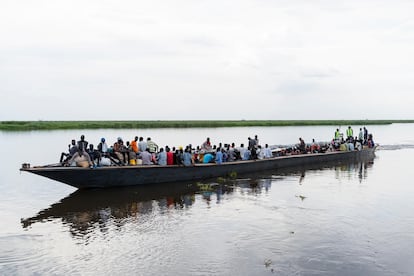Increase in armed conflicts causes record of 120 million displaced people in the world
If all refugees, internally displaced persons, asylum seekers, and other people in need of international protection were brought together in one country, they would form the 12th largest in the world, with a population similar to that of Japan

At the end of 2023, the United Nations High Commissioner for Refugees (UNHCR) estimated the number of forcibly displaced persons worldwide at 117.3 million. By May 2024, that figure had risen to 120 million. It is a trend that has been steadily increasing for the past 12 years and which in 2024 has been exacerbated by new wars, such as those in Sudan and Gaza, but also by others such as the frozen conflicts in Syria or Myanmar. This is the main denunciation of the latest annual report on global trends in forced displacement published Thursday by UNHCR, and which calls for a solution as simple to propose as it is difficult to achieve: peace.
Raouf Mazou, UNHCR’s deputy high commissioner for operations, sums up in just a few sentences how humanity has reached this point: “We are seeing more and more conflicts. They are being resolved less and less because the mechanisms that exist to resolve them do not work. As a result, the numbers of forced displacement are increasing,” he says during a video interview.

Forcibly displaced persons
Internally
displaced
Refugees
(under UNHCR
mandate)
Asylum
seekers
Palestinian
refugees
(under UNRWA
mandate)
Other persons
in need of
international
protection
Cumulative figure each year
118.6
120 million people
100
80
60
40
20
0
2014
15
16
17
18
19
20
21
22
23
Source: UNHCR.

Forcibly displaced persons
Internally
displaced
Refugees
(under UNHCR
mandate)
Asylum
seekers
Palestinian
refugees
(under UNRWA
mandate)
Other persons
in need of
international
protection
Cumulative figure each year
120 million people
118.6
100
80
60
40
20
0
2014
2015
2016
2017
2018
2019
2020
2021
2022
2023
Source: UNHCR.
As far as the number of armed conflicts is concerned, the data attest to this increase: in 2023, the world reached the highest peak since World War II, with 56 active conflicts and 92 countries involved, according to the latest data from the Institute for Economics and Peace, published Tuesday. The frequency, scope, duration, and intensity of conflicts are closely related to the number of people forced to flee each year, both internally and to other countries.
If these 120 million refugees, internally displaced persons, asylum seekers, and other people in need of international protection were brought together in one country, they would form the 12th largest in the world, with a population similar to that of Japan or twice that of France. And it would be a very young country: 40% of its population would be aged under 18.

Forcibly displaced persons
World population
Men
Women
3%
4%
60+
6%
8%
27%
26%
18-59
28%
28%
20%
20%
0-17
15%
14%
40% of forcibly displaced persons are under
18 years of age (29% of the world's population
is in that age range)

Forcibly displaced persons
World population
Men
Women
3%
4%
60+
6%
8%
27%
26%
18-59
28%
28%
20%
20%
0-17
15%
14%
40% of forcibly displaced persons are under 18 years of age
(29% of the world's population is in that age range)
The UNHCR report details the numbers of different population groups that have had to flee their homes through force majeure, mainly due to violence and conflicts but also climatic disasters. The largest group is that of internally displaced persons: 68.3 million people who moved within their own countries due to war-related causes alone, mainly in Sudan, and 76 million if those who did so due to natural disasters are added. Refugees at the end of the year numbered 43.4 million, also mainly from Sudan. Another 5.8 million were in need of international protection, predominantly Venezuelans. Also included in the tally are six million under the mandate of UNRWA, the U.N. agency for Palestinian refugees, and 4.4 million stateless people.
The UNHCR report also reveals that the number of new individual asylum applications increased over the past year to 3.6 million. However, there was a 17% drop in the total number of those seeking international protection in 2023 to 5.6 million, mainly due to fewer refugees from Ukraine applying for and being granted temporary protection, mostly in European countries. The total number of asylum seekers awaiting a decision at the end of the year increased by 26% to 6.9 million, as new individual asylum applications outnumbered resolutions.

Climate threat
Displaced population
Low
Severe
10 million
Moderate
Extreme
5 million
500,000
High
Conflict

Displaced population
Conflict
Climate threat
Low
Severe
10 million
Moderate
Extreme
5 million
500,000
High
The United Nations appeals to the responsibility and solidarity of all countries to support the financial cost of protecting these people, especially the more developed countries, which only host 25% of the world’s refugee population. The other 75% have either remained within their own borders or in neighboring countries because they hope to return home as soon as possible. The result is that, in the end, it is the low-income countries that receive the most refugees, because that is also where the largest number of armed conflicts are flaring up. “When you receive refugees, you receive them on behalf of the rest of the world, so the whole international community has to contribute, including the richer countries,” Mazou points out.
The Sudan crisis is the prime example: more than 7.1 million new internal displacements and more than 1.9 million outward displacements have been recorded since April 2023. By the end of 2023, a total of 10.8 million Sudanese people had been displaced within and outside the country, and neighboring nations with their own crises such as South Sudan have received much of those flows. “There have been numerous international appeals and conferences, but South Sudan has only received 16% of the funding it needs to care for the displaced population,” says the UNHCR representative, who also calls for aid not only for urgent humanitarian assistance, but also for the future development of displaced communities. “If you are displaced after five years, you don’t want to continue receiving humanitarian assistance. You have to provide means for people to be able to feed themselves and have a normal life. Whatever they were doing or whatever work they were doing, they should be able to continue doing it in the country that received them. That is where solidarity is needed,” he says.
For UNHCR High Commissioner Filippo Grandi, it is time for the parties to the conflicts to respect international law and the basic rules of war. “The reality is that without greater cooperation and joint efforts to address conflict, human rights violations or the climate crisis, displacement numbers will continue to rise, bringing with them more suffering and costly humanitarian responses,” he said during the press conference to launch the report.
Seven crises behind the numbers
1. Palestine: At the end of 2023, two months after the start of the Israeli offensive, there were six million Palestinian refugees under UNRWA mandate, of which 1.7 million were in Gaza. UNRWA estimates that 75% of the inhabitants of the Strip were forcibly displaced in 2023.
2. Syria: The largest displacement crisis in the world, with 13.8 million forcibly displaced people inside and outside the country, of which 7.2 million remain inside Syria, many of them in a critical humanitarian situation. Another 6.5 million Syrian refugees and asylum seekers are scattered throughout the rest of the world.
3. Sudan: The armed conflict that began in April 2023 has caused one of the world's largest humanitarian crises. More than 7.1 million people have been forcibly displaced, and 1.9 million more have fled to other countries.
4. Myanmar: One of the deepest and most complex humanitarian crises in the world since the military took power in 2021. Three million people are displaced within Myanmar, and 1.3 million have fled overseas. Nearly one million people are stateless Rohingya. They live as refugees in Bangladesh and are mostly dependent on humanitarian aid.
5. Afghanistan: The economic, humanitarian, and human rights situation deteriorated significantly after the return of the Taliban regime in 2021, particularly for women and girls. More than 10 million Afghans remain displaced and nearly half of the country's population of 40 million faces severe acute food insecurity.
6. Ukraine: Two years after the Russian invasion, attacks and shelling continue to destroy homes and claim lives. Some 6.5 million Ukrainian refugees remain far from their homes, and 3.7 million are internally displaced.
7. DR Congo: The resurgence of fighting in the east of the country has exacerbated the humanitarian crisis; 7.9 million Congolese remain displaced, most in a critical humanitarian situation.
Sign up for our weekly newsletter to get more English-language news coverage from EL PAÍS USA Edition
Tu suscripción se está usando en otro dispositivo
¿Quieres añadir otro usuario a tu suscripción?
Si continúas leyendo en este dispositivo, no se podrá leer en el otro.
FlechaTu suscripción se está usando en otro dispositivo y solo puedes acceder a EL PAÍS desde un dispositivo a la vez.
Si quieres compartir tu cuenta, cambia tu suscripción a la modalidad Premium, así podrás añadir otro usuario. Cada uno accederá con su propia cuenta de email, lo que os permitirá personalizar vuestra experiencia en EL PAÍS.
¿Tienes una suscripción de empresa? Accede aquí para contratar más cuentas.
En el caso de no saber quién está usando tu cuenta, te recomendamos cambiar tu contraseña aquí.
Si decides continuar compartiendo tu cuenta, este mensaje se mostrará en tu dispositivo y en el de la otra persona que está usando tu cuenta de forma indefinida, afectando a tu experiencia de lectura. Puedes consultar aquí los términos y condiciones de la suscripción digital.
More information
Archived In
Últimas noticias
Most viewed
- Reinhard Genzel, Nobel laureate in physics: ‘One-minute videos will never give you the truth’
- Oona Chaplin: ‘I told James Cameron that I was living in a treehouse and starting a permaculture project with a friend’
- Pablo Escobar’s hippos: A serious environmental problem, 40 years on
- Why we lost the habit of sleeping in two segments and how that changed our sense of time
- The fall of a prolific science journal exposes the billion-dollar profits of scientific publishing










































